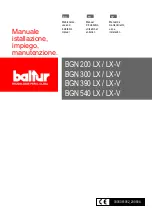
PROCEDURE 2—RECOMMENDED INSTALLATION PRACTICES AND COMBUSTION CHECK
In order to obtain optimum performance from oil burner, the following setup procedures must be followed:
1. A test kit (Bacharach No. 5022 kit or equivalent) to measure smoke, stack draft, over-fire CO
2
, and stack temperatures MUST be used in
order to obtain proper air band setting. Although all of the above measurements are required for optimum setup and efficiency data, the most
important readings that must be taken are smoke number, over-fire draft, and stack draft.
2. The proper smoke number has been established by engineering tests to be between 0 and 1. This degree of smoke emission is commonly
referred to as a “trace” of smoke. It is recommended to use a Bacharach true spot smoke test set or equivalent.
3. In order to ensure proper draft through furnace, a barometric draft regulator (supplied with furnace) must be installed as close to outlet of
furnace as possible. In order for this device to function properly, barometric damper must be mounted with hinge pins horizontal and face
of damper vertical (see instructions included with damper). The draft regulator should be adjusted after furnace has been firing for at least
10 minutes, and stack draft should be measured and set between —0.025 and —0.035 in. wc. The draft should be checked with a Bacharach
MZF draft gauge or equivalent.
4. The over-fire draft, which is taken through hole provided in observation door, is a measurement necessary to determine if there is blockage
between oil burner and flue outlet.
There should be a pressure drop of between 0.005 and 0.015 in. wc through furnace. This would set the range of the over-fire draft between —0.01
and —0.03 in. wc. A reading above —0.01in. wc. (for example, +0.1in. wc) would indicate that furnace is in an extremely high-pressure condition
in primary section. This condition may be caused by excessive combustion air due to air band being open too wide, or a lack of flue draft (chimney
effect), or some other blockage, such as soot, in secondary section of heat exchanger.
5. The CO
2
and stack temperature instruments enable you to obtain data required to determine thermal efficiency of furnace.
6. An oil filter should be installed as close to burner as possible with ALL oil burners and is essential on lowing firing rate burners. The use
of a low pressure drop oil filter such as General Filter, Inc. model # 1A-25A or equivalent is recommended. It is critical that oil capacity
be equivalent or greater that fuel pump gear capacity. For a 2–pipe system, this is 25 gph.
7. The oil pressure regulator is factory set to give nozzle oil pressures of 100 psig. The firing rate noted on nameplate may be obtained with
“standard” nozzles by adjusting pump pressure as noted in Table 4 or on label on furnace.
On a new installation, air entrapped in oil line leading from tank to nozzle must be thoroughly purged in order to prevent excessive after drip. The
oil pump is provided with a special fitting which allows purging of any air between tank and oil pump. The proper procedure for performing this
operation is as follows:
a. Place a piece of clear plastic 1/4 in. diameter tubing over purge fitting on oil pump.
b. Start oil burner, then open purge fitting and allow burner to run until purge tube is completely free of air bubbles.
c. Tighten purge fitting. Allow oil to run to nozzle and fire burner.
d. If purging takes longer than 30 seconds and no flame has been established, burner stops. Push reset button on top of primary control to
restart burner.
e. For detailed information on operation of primary control, refer to instructions included with furnace.
PROCEDURE 3—FAN ADJUSTMENT CHECK
This furnace is equipped with a 3–speed direct drive motor to deliver a temperature rise (between return and supply plenums) within range specified
on rating plate at external duct static pressure noted on rating plate.
CAUTION: When operating furnace in heating mode, static pressure and temperature rise (supply-air temperature
minus return-air temperature) must be within those limits specified on rating label. Failure to follow this caution could lead
to sever furnace damage.
Adjust fan speed so that temperature rise is within range specified on rating plate. Consult wiring diagram for speed changes on direct-drive motor.
To adjust fan off time, set DIP switches on control board to obtain desired timing (see Fig. 1).
PROCEDURE 4—LIMIT CONTROL CHECK
After furnace has been in operation for at least 15 minutes, restrict return-air supply by blocking filters or closing return registers and allow furnace
to shut down on high limit. The burner should shut off, and main blower should continue to run.
Remove restriction, and burner should come back on in a few minutes.
PROCEDURE 5—FOR YEAR-ROUND AIR CONDITIONING
This furnace is designed for use in conjunction with cooling equipment to provide year-round air conditioning. The blower has been sized for both
heating and cooling, however, fan motor speed may need to be changed to obtain necessary cooling airflow.
PROCEDURE 6—HEATING
The blower speed is factory set to deliver required airflow at normal duct static pressure.
Table 4–Burner, Nozzle, and Pump Pressure Chart
UNIT SIZE
FIRING RATE GAL/HR (US)
PUMP PRESSURE (PSIG)
BECKETT OIL BURNER
Model
Nozzle
036105
0.76
103
AFG
0.75 gph/70° Hollow
048125
0.90
100
AFG
0.90 gph/70° Hollow
060155
1.12
104
AFG
1.10 gph/70° Hollow
—7—


































